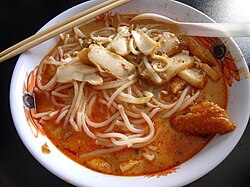 | |
| Alternative names | mie kari |
|---|---|
| Type | Noodle soup |
| Region or state | Maritime Southeast Asia |
| Associated cuisine | Malaysia, Singapore, [1] [ page needed ] Indonesia |
| Main ingredients | Noodles, sambal (chilli paste), coconut milk, herbs |
Curry mee [a] is a Maritime Southeast Asian spicy noodle soup garnished with various toppings. In Indonesia, it is called mie kari. [2] In Johor and Singapore, it is sometimes called curry laksa . [b] Numerous variants of the dish, including preparations with a drier or thicker gravy, exist in both the countries of Malaysia and Singapore.



